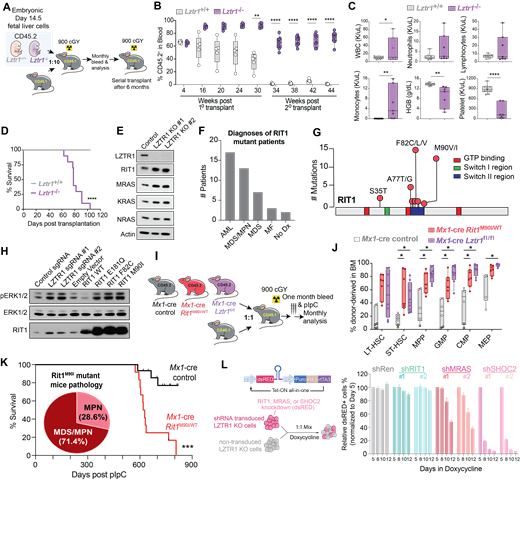Abstract
Recently, the protein LZTR1 (leucine zipper-like transcriptional regulator 1) was discovered as an adaptor for a cullin 3 complex responsible for ubiquitin-mediated degradation of RAS proteins. While these data provided a novel mechanism for RAS protein regulation, there is considerable controversy as to which RAS paralogs are physiologic substrates of LZTR1. In parallel, dysregulated LZTR1 expression via aberrant splicing and mutations in both LZTR1 as well as the RAS GTPase and LZTR1 substrate RIT1 were identified in patients with clonal hematopoietic disorders. However, the effects of these alterations on normal and maliganant hematopoiesis have not been evaluated. Here we utilized a series of genetically engineered murine models for germline and conditional deletion of LZTR1, RIT1, and expression of oncogenic RIT1 mutant which revealed a key role for LZTR1 in the regulation of hematopoietic stem cell (HSC) self-renewal and delineated a series of LZTR1-regulated substrates in hematopoietic cells.
Consistent with a role for LZTR1 alterations in the Noonan Syndrome, germline homozygous deletion of Lztr1 was associated with lethality between embryonic day 17.5 and birth. Lztr1-/- fetuses had massive dyserythropoiesis and apoptosis of fetal liver hematopoietic cells. Competitive transplantation of E14.5 Lztr1 null fetal liver or bone marrow from 6-week-old Mx1-cre Lztr1 conditional knockout (cKO) mice resulted in striking increased self-renewal in primary and secondary competitive transplantation assays in vivo (Fig.A-B). Interestingly, recipient animals reconstituted with Lztr1-/- cells developed fatal myeloid and lymphoid leukemias characterized by anemia, thrombocytopenia, and increased myeloid and B-lymphoid cells (Fig.C-D).
In order to identify the LZTR1 substrates responsible for effects on HSCs, we evaluated levels of all RAS GTPases in Lztr1 null HSCs. This revealed elevated KRas, NRas, MRas, and Rit1 protein in LZTR1 KO cells (Fig.E), with RIT1 being most prominently elevated. Evaluation of a cohort of 4,113 patients with hematologic malignancies identified 41 patients with somatic RIT1 mutations, the majority of which cluster in the switch II region and escape LZTR1-mediated ubiquitination, resulting in RIT1 protein accumulation (Fig.F-H). Given that the impact of RIT1 mutations on hematopoiesis is unknown, we next compared Lztr1 cKO with conditional expression of one of the most common leukemia-associated RIT1 mutants that escapes LZTR1-mediated ubiquitin (Rit1 M90I). Both Lztr1 cKO and Rit1 M90I conditional expression conferred GM-CSF hypersensitivity to HSCs in vitro, cytokine independent growth to human AML cell lines in vitro, and strong competitive self-renewal in vivo (Fig. I-J). Consistent with RIT1 mutations being found primarily in myeloid neoplasm patients, aged Mx1-cre Rit1M90I/WT mice developed fatal MPN, MDS, and mixed MDS/MPN disorders (Fig.K), which were serially transplantable into sublethally irradiated recipients.
Despite convergent effects of LZTR1 and RIT1 on clonal HSC advantage, LZTR1 null cell lines did not solely require RIT1 for HSC advantage as revealed by Lztr1/Rit1 double KO mice. We therefore next carried out a series of experiments in RAS-less cells and whole genome CRISPR screens to delineate factors required for LZTR1 mediated hematopoietic transformation. This revealed that KRAS as well as MRAS and its RAF phosphatase partner SHOC2 were selective dependencies for LZTR1-mediated transformation. These data indicate that multiple RAS GTPases as well as RAF activation are required for LZTR1-mediated transformation (Fig.L).
While considerable prior research has evaluated oncogenic alleles of RAS which alter RAS-GTP hydrolysis on hematopoiesis, the role of modulating RAS protein abundance on hematopoiesis is unknown. Here we identify RAS proteolysis as a novel regulator of HSC function, define the spectrum of RIT1 mutations in leukemia, and identify LZTR1 and RIT1 mutations as drivers of leukemogenesis. The discovery of RAS proteolysis as a novel driver of leukemogenesis has important therapeutic implications given efforts to therapeutically degrade RAS family members. Finally, the clinical importance of K/NRAS mutations on resistance to therapies in AML motivates future studies on the potential clinical impact of LZTR1 and RIT1 alterations in myeloid neoplasm patients.
Abdel-Wahab: H3B Biomedicine: Consultancy, Research Funding; Merck: Consultancy; Foundation Medicine Inc: Consultancy; Prelude Therapeutics: Consultancy; LOXO Oncology: Consultancy, Research Funding; Lilly: Consultancy; AIChemy: Current holder of stock options in a privately-held company, Membership on an entity's Board of Directors or advisory committees; Envisagenics Inc.: Current holder of stock options in a privately-held company, Membership on an entity's Board of Directors or advisory committees.


This feature is available to Subscribers Only
Sign In or Create an Account Close Modal